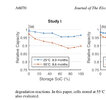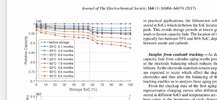I hope you can relax despite the ’bumpy ride’. You know that the bumps is BMS estimation induced and not real changes in range/capacity.
I had one ’bump’, I guess I caused it myself.
The intent was to do an opposite BMS calibration to take the range down from full range (not really probable) and hoping it would settle at the real range. My own calculation said 78.5-79kWh( ~ 495km range), like
this line.
Wen the range dropped, it dropped to about 480-485km and 75.7-77kWh which was clearly lower than my estimate.
During this time I could see that after a long drive, for example parking with 32%, the car would increase the SOC-number to 33% even before sleeping and after it slept it would be 34%. This indicates that the BMS is off, the capacity is estimated too small which cause a SOC calculation during driving to calculate to much SOC used.
I ”knew” this, also made a 100-0% drive that indicated a capacity around 79kWh.
After about four mounths the BMS also learned and now the range and capacity is per my calc (494km / 78.4kWh nominal).
View attachment 878732
I know some say the BMS estimate is very exact, but i also know my BMS was about 3.5% to optimistic and then some time later it was about 3.5% pessimistic.
Now it is back on track, after a longer drive the SOC stays at more or less the same after sleeping so for now the BMS is on track.
Rollercoasting is probably Teslas choice of how to do it some times. In the end, it will show the correct number two times on every big bump, both when going up and when going down





